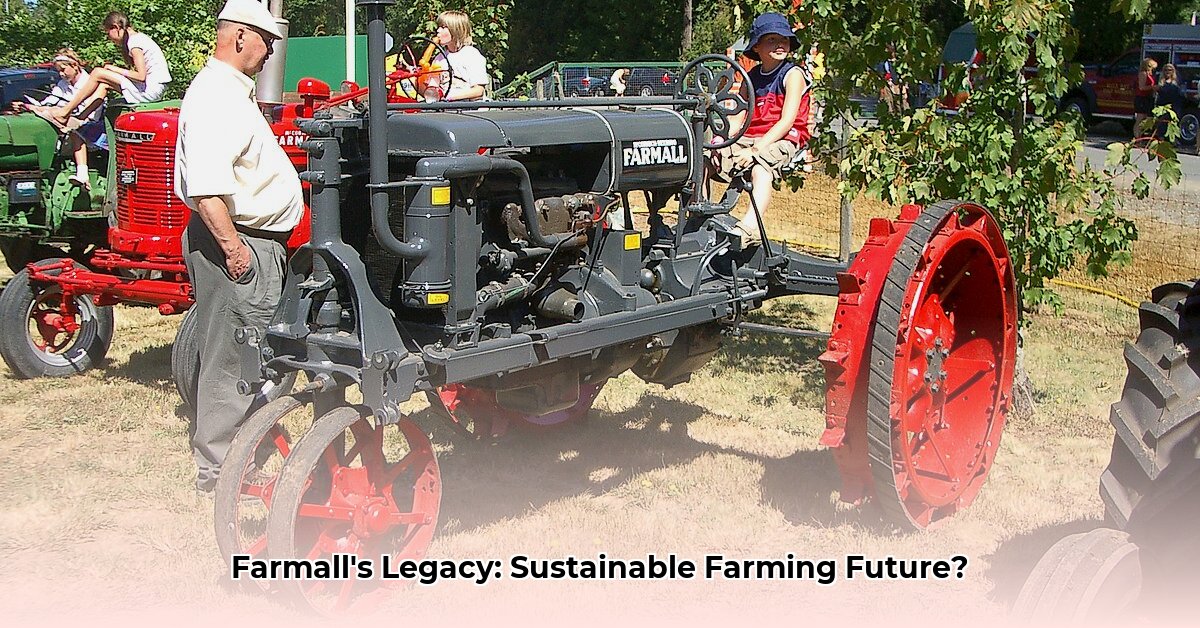
The roar of the Farmall engine, a sound synonymous with American agriculture, echoes through history. But is its legacy one of solely progress, or does it hold lessons for sustainable farming practices today? This narrative delves into the Farmall's evolution, its profound impact on farming, and the complex question of its role in a future focused on environmental responsibility. Learn more about electric Farmall conversions at this site.
The Farmall Revolution: Mechanizing the American Heartland
Before the Farmall, farming was backbreaking labor. Horses and human muscle powered the arduous tasks of plowing, planting, and harvesting. The arrival of the Farmall F-12 in the 1920s fundamentally transformed this reality. Its affordable price point, coupled with its revolutionary design, brought mechanization to the masses, impacting family farms across the nation. Imagine the sheer transformative power: a single machine replacing the strength of multiple horses and countless hours of human toil. This was more than just a machine; it was a symbol of progress and empowerment.
Innovation on the Fields: Evolution of a Legend
The Farmall wasn't a static design. International Harvester continuously refined the tractor, responding to the evolving needs of farmers. From the early F-12 to the subsequent models like the H and M, each iteration boasted improvements in engine power, fuel efficiency, and compatibility with a wider range of agricultural equipment. This continuous improvement reflects a crucial element of the Farmall's success – its adaptability to changing agricultural practices and farmers' needs. This adaptability, rarely seen in other mechanized agricultural equipment, arguably contributes to its lasting appeal.
The Double-Edged Plow: Efficiency's Environmental Costs
The efficiency gains brought about by the Farmall were undeniable. Farmers could cultivate larger plots of land, increasing yields and contributing to economic growth. The resulting abundance of food significantly impacted global food security. However, this unprecedented efficiency came at a cost. The increased reliance on petroleum-based fuels and the expansion of agricultural land, often at the expense of natural habitats, had substantial environmental implications. Did the benefits of increased agricultural output outweigh the long-term consequences for the planet? This question remains a vital component of the Farmall's legacy.
Farmalls Today: A Sustainable Second Act?
The Farmall's story is far from over. While modern tractors boast sophisticated technology and precision capabilities, vintage Farmalls offer unique potential for sustainable farming practices. Their relative simplicity, affordability, and durability make them intriguing options for modern applications. Can these workhorses of the past play a role in shaping a greener future?
Reviving the Past: Adapting Farmalls for Sustainable Practices
The potential for integrating vintage Farmalls into modern sustainable farming isn't about replacing modern equipment but rather finding innovative ways to repurpose them.
Restoration and Repurposing: Many older Farmalls, with some TLC, can be restored and adapted to specific tasks on smaller, sustainable farms—think tilling smaller fields, transporting goods sustainably, or even powering small-scale irrigation systems, offering unique niche applications.
Hybrid Power: The marriage of vintage Farmall chassis with updated, sustainable power sources is an intriguing possibility. Converting them to electric or biofuel operation could drastically lower their environmental footprint, while retaining some of their robustness and simplicity.
Targeted Applications: Farmalls prove ideal for tasks that don't necessarily require the precision guidance of the latest GPS-guided tractors. Their adaptability to different farming styles showcases their versatility and potential within modern, sustainable farming methods.
Dr. Eleanor Vance, Professor of Agricultural History at Cornell University, notes, "The Farmall's enduring appeal lies not just in its mechanical ingenuity, but in its embodiment of American ingenuity and adaptability. Its potential for integration into modern sustainable agriculture demands further exploration."
Lessons Learned: A Legacy of Progress and Responsibility
The Farmall's history serves as a potent reminder of the interconnectedness of technology, agriculture, and environmental sustainability. Its story highlights both the remarkable progress enabled by mechanization and the critical need to consider the long-term environmental implications of technological advancements. The Farmall’s journey compels us to learn from the past to build a more sustainable future. Its legacy urges us to embrace innovation while carefully considering its consequences – a lesson as relevant today as it was a century ago.
Charting a Course Towards Sustainability: Key Considerations
| Stakeholder Group | Short-Term Goals | Long-Term Goals |
|---|---|---|
| Small-scale Farmers | Restore and repurpose Farmalls for specific sustainable tasks. | Implement Farmalls in diverse organic and precision farming techniques. |
| Agricultural Researchers | Evaluate the comparative fuel efficiency of Farmalls and modern tractors. | Assess the complete life-cycle environmental impact of Farmalls. |
| Tractor Manufacturers | Incorporate design elements from Farmalls into new sustainable tractors. | Develop tractors powered by alternative, sustainable fuels. |
| Policymakers | Support programs facilitating the restoration of vintage equipment. | Implement policies promoting sustainable farming practices and equipment choices. |
The Farmall's legacy is multifaceted and evolving. Further research and innovative applications hold the key to unlocking its full potential within the context of sustainable agriculture. This ongoing dialogue necessitates collaborative efforts across multiple stakeholders to ensure the lessons of the past inform a truly sustainable future.